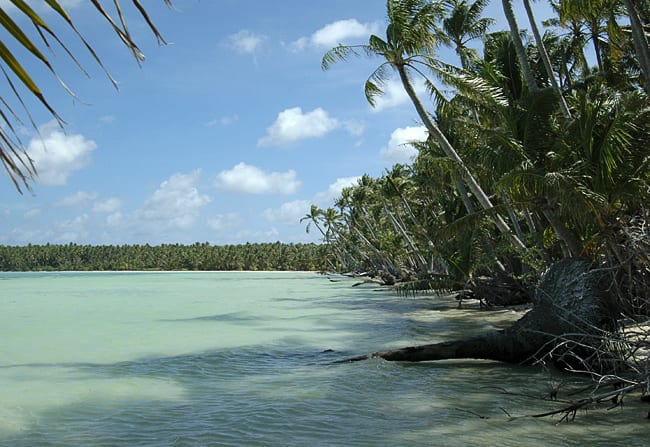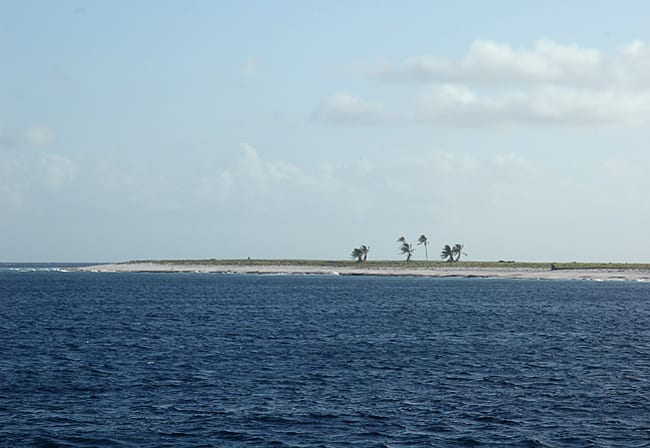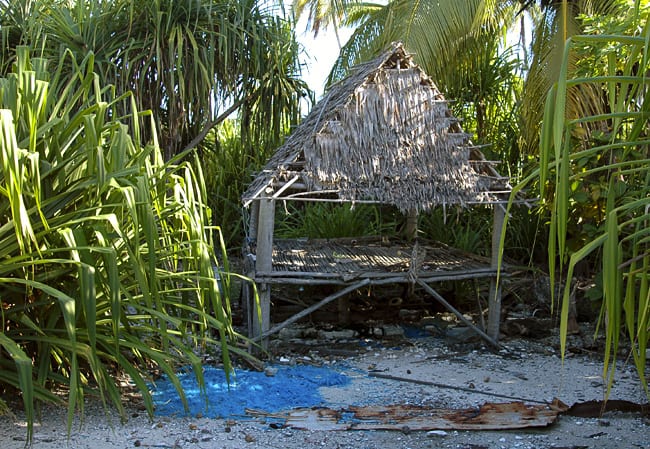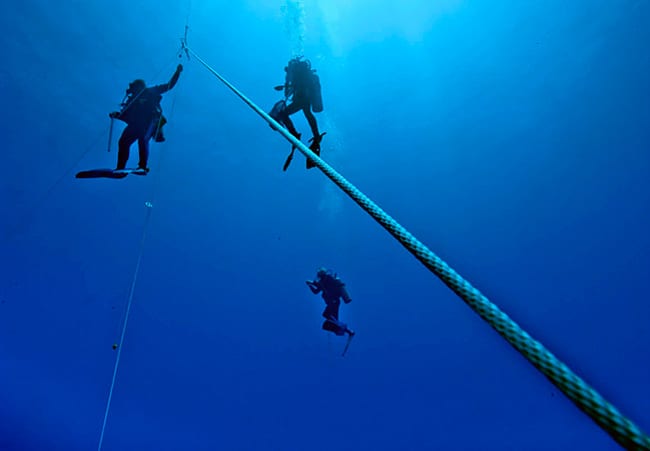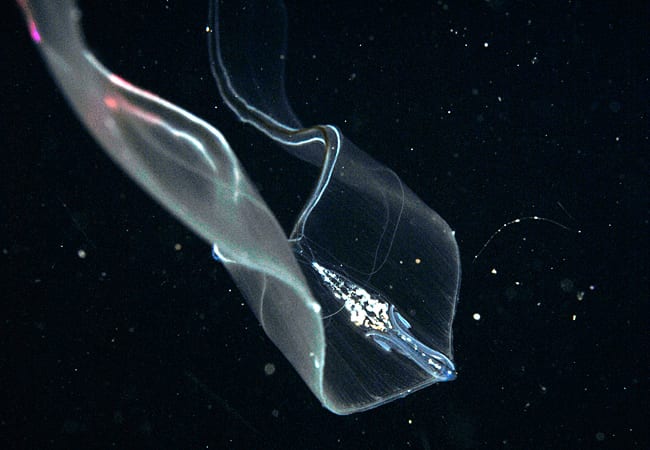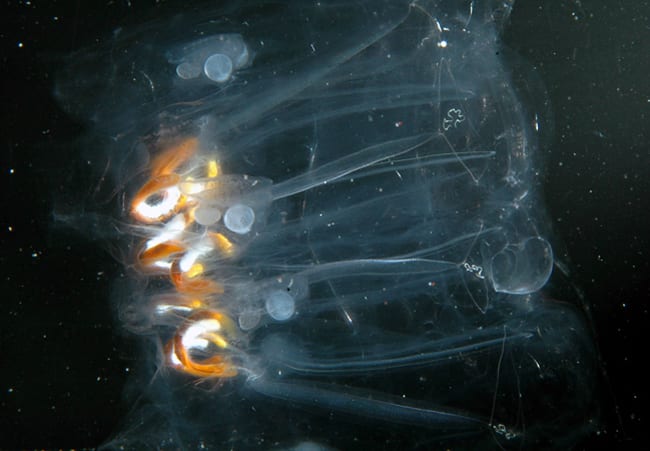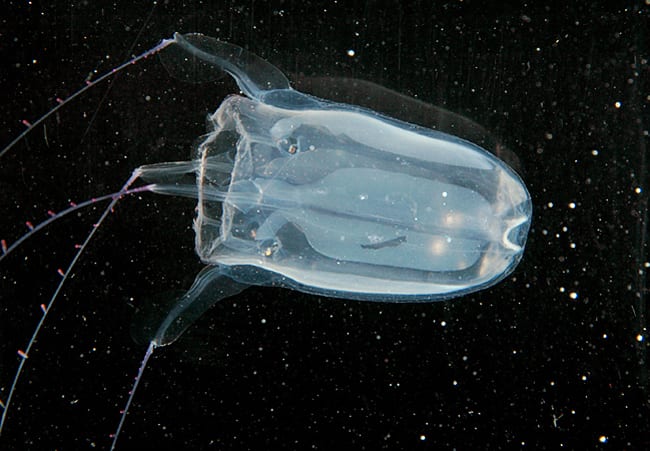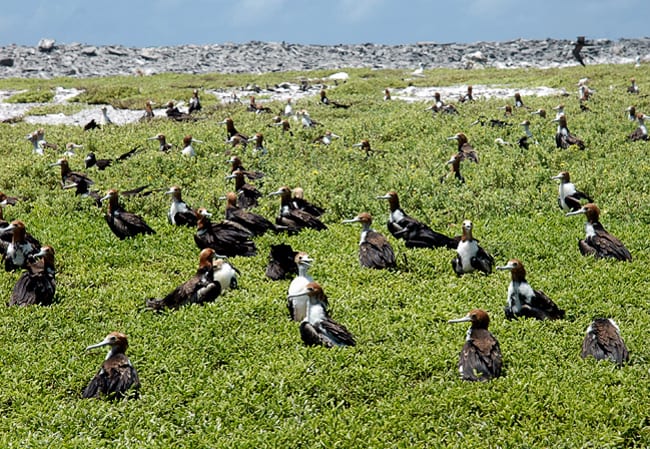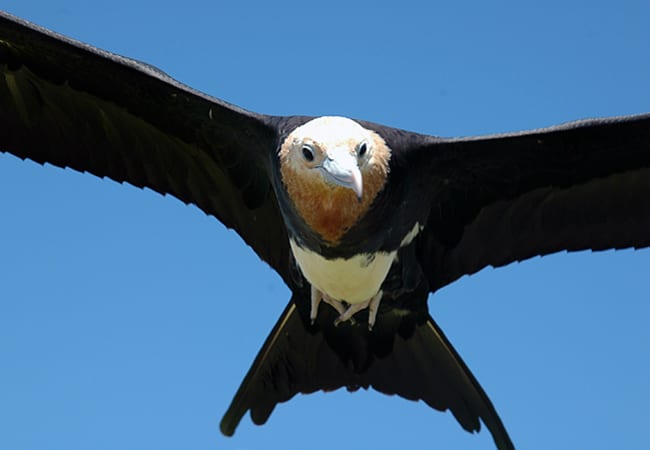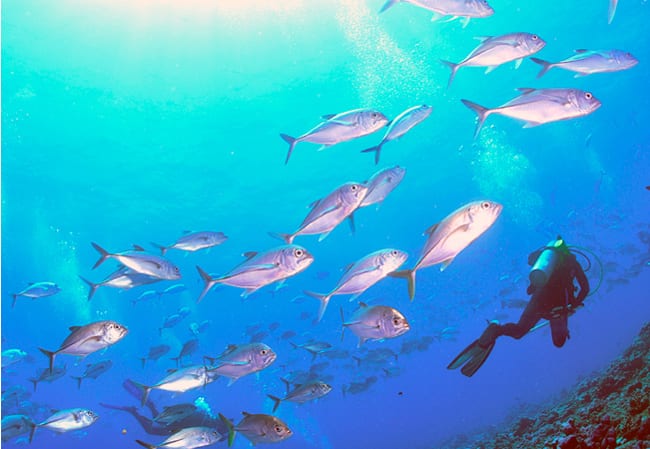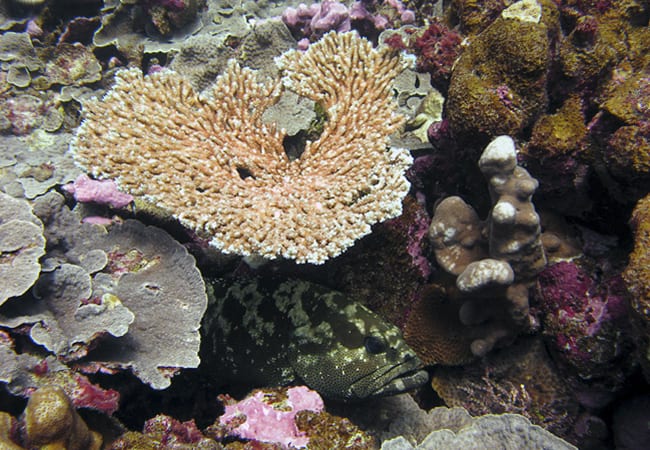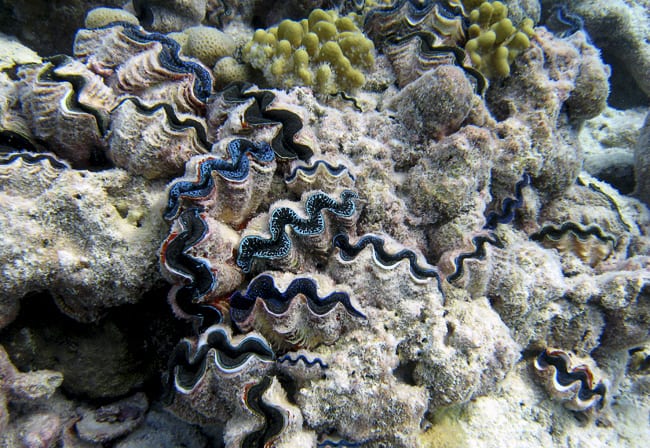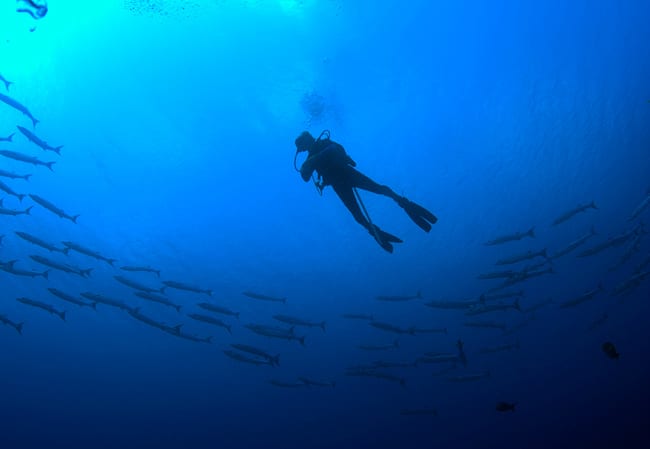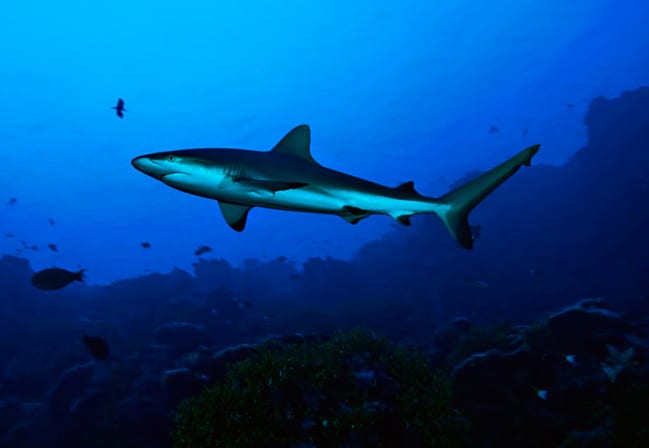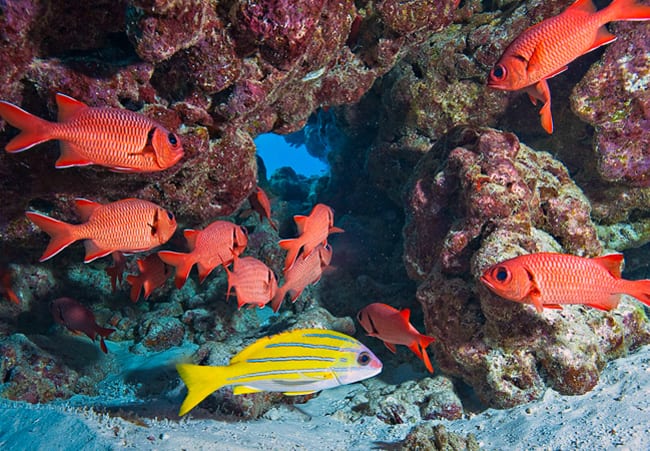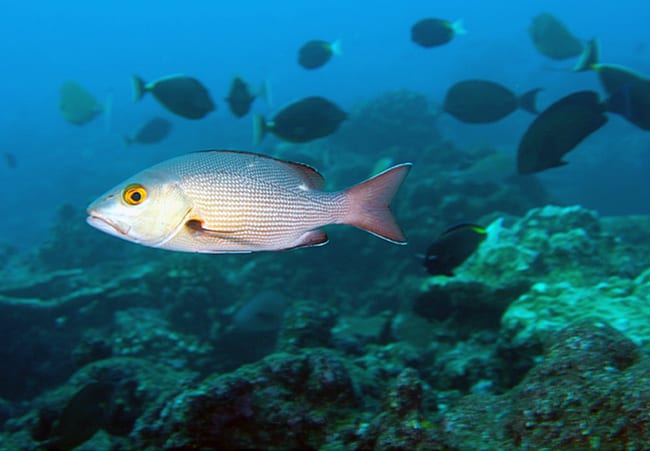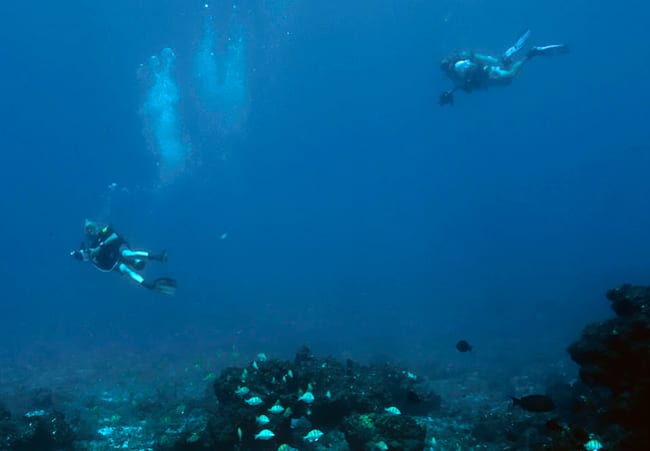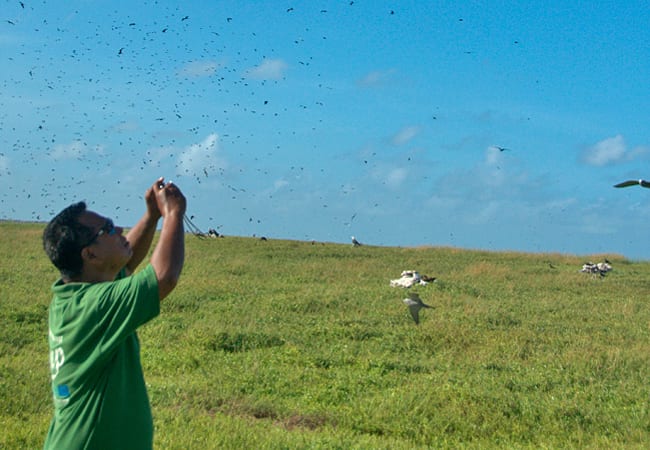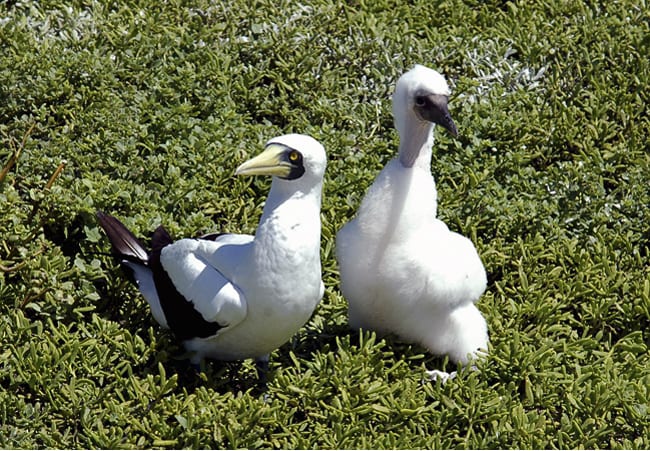- The coral atoll of Nikumaroro is one of the Phoenix Islands in the western equatorial Pacific. Atolls are low ring-shaped islands of coral rubble that form over millennia as coral reefs grow around volcanic islands that sink, leaving the coral ring exposed. A classic atoll, Nikumaroro has coconut palms ringing a warm, shallow central lagoon that is a nursery for young reef fish. An abundance of bird droppings contributes to the water’s milky appearance. (Photo by Larry Madin, Woods Hole Oceanographic Institution)
- Enderbury is low and very small, less than 2 square miles in area, but this almost treeless island is home for thousands of sea birds. Not all islands that formed as coral atolls have lagoons: Enderbury has only a shallow wet area in its center, no longer connected to the ocean. Like many South Pacific islands, Enderbury was heavily mined in the 19th century for phosphorous-rich bird guano, which was used to make fertilizer and gunpowder. (Photo by Larry Madin, Woods Hole Oceanographic Institution)
- Humans have settled Orona Island more than once. It is a 5-by-2-mile well-treed ring-shaped atoll with a large central lagoon and limited fresh water. Tukabu Teroroko, director of the Phoenix Islands Protected Area (PIPA) for Kiribati, pointed out stone enclosures from prehistoric Polynesian settlements. He said that there were settlements here in the 1930s, the 1950s, and most recently from 1996 to 2005. Some 200 people lived here to fish and produce copra (coconut meat), then left, returning to Kiribati when they could no longer support themselves here. The island will now remain uninhabited. (Photo by Larry Madin, Woods Hole Oceanographic Institution)
- Many of the animals that live in the open ocean are transparent jelly-like creatures, such as jellyfish and other fragile, diaphanous forms. Even though they can be large, they are often too delicate to capture in nets. Scientists studying them SCUBA dive in the open ocean, entering the boundless watery realm to collect the transparent animals drifting by. Because divers are surrounded by endless blue in all directions, a system of lines is necessary to keep them from drifting away without realizing it. (Photo by Jim Stringer)
- “Kiribati had the foresight to protect the open water here,” said WHOI biologist Larry Madin. “The water column—the ocean over the deep seafloor—is PIPA’s largest habitat. Single-celled ocean algae create food using the energy from sunlight. Zooplankton eat these cells and are the link in the food chain to larger animals such as fish, turtles, and whales.” This plankton animal, a ribbon-shaped relative of jellyfish called “Venus’ girdle,” drifts in the open water, trying to encounter some of the sparse food particles with its sticky surface. (Photo by Larry Madin, Woods Hole Oceanographic Institution)
- A colony of 12 salps drifts through the distant tropical waters of the Phoenix Islands. The salps are transparent tubular animals arranged around a center, like segments in an orange. For food, they filter tiny particles out of the water, and the orange loops are their stomachs. Each salp, both mom and pop, carries a baby (see the small tube attached to two circles, upper left) and a testis (the bright white areas near the stomachs.) (Photo by Larry Madin, Woods Hole Oceanographic Institution)
- Diving in the open ocean to look for animal plankton, or marine life related to jellyfish, “blue-water” divers must concentrate to see transparent animals against the blue background of water. Sometimes you see a jellyfish you hope you don’t touch directly, such as this cubomedusa, or “box jelly,” which delivers highly toxic stings. Box jellyfish possess image-forming eyes—the dots between the tentacles—though they have no nervous system or brain. (Photo by Larry Madin, Woods Hole Oceanographic Institution)
- The small coral islands of the remote Phoenix Islands are important resting and nesting areas for millions of seabirds, some of them rare and endangered. Over time, seafaring Polynesians, explorers, whalers, and miners of bird guano introduced cats, rats, and even pigs—all of which consume bird eggs. These non-native species have reduced seabird populations on the islands, and the Kiribati government is working to eradicate them from PIPA. Meanwhile, on McKean Island, juvenile frigate birds await their parents’ return from sea. (Photo by Larry Madin, Woods Hole Oceanographic Institution)
- McKean Island harbors one of the largest nesting populations of lesser frigate bird (Fregata ariel). Built for flying, frigate birds are almost always in the air unless they are nesting. They capture fish by snatching them from the water while flying close to the surface. Unafraid of humans, many of these large birds flew right up to photographers. (Photo by Larry Madin, Woods Hole Oceanographic Institution)
- An El Niño in late 2002 affected the equatorial Pacific Ocean, especially the Phoenix Islands. These global weather patterns bring high water temperatures that can cause corals to lose their internal symbiotic algae, which causes the corals to bleach and die. Scientists on the expedition who saw the Phoenix Islands in previous years wondered how PIPA’s reefs had fared. Many corals had died, but scientists found new corals growing rapidly. The surprise was that fish were still abundant on the reefs. With fishing prohibited in PIPA, reef fish abounded, both herbivores and predators such as this school of hundreds of silvery trevally. (Photo by Greg Stone, New England Aquarium and Conservation International)
- Reef fish specialist Stuart Sandin spied this “camouflage grouper” under a coral. The scene is a snapshot of the recovering Kanton Island reef: corals re-growing, evidence of fish grazing on coral (white patches at the tips of the right-center coral), patches of pink algae that corals will settle on, and the grouper, a predator. “Here in PIPA we gained insight into the best fate possible for reefs in the coming century,” said Sandin. “We can manage local stressors [overfishing and coastal construction]—but global insults [such as temperature increases] will continue. Our hope is that this kind of protection from fisheries and human settlement will afford reefs protection in the face of a significantly altered global environment.” (Photo by Stuart Sandin, Scripps Institution of Oceanography)
- A jumble of Tridacna (giant clams) finds a perfect home in the clear, shallow channel at the entrance to Orona atoll’s lagoon in the Phoenix Islands. These clams live in tropical water, their blue mantle tissue harboring symbiotic algae that make food from the abundant sunlight. Remarkably, every clam seems to show off different patterns and shades of blue. They are hard to photograph: When a fish’s (or diver’s) shadow falls across any clam, it pulls in its mantle and pulls its shell nearly closed. (Photo by Randi Rotjan, New England Aquarium)
- At the start of a dive in Kanton Lagoon’s entrance, Alan Dynner (chair of New England Aquarium’s Board of Overseers) found himself in the center of a swirl of more than a hundred barracuda. Predators are a critical part of healthy reefs, keeping grazing fish populations healthy and limited. Researchers on the PIPA expedition were heartened to see so many predators—and large numbers of their prey, suggesting that reefs protected from fishing and other human impacts may be able to remain oases of biodiversity during times of global climate change. (Photo by Greg Stone, New England Aquarium and Conservation International)
- Several expedition scientists and divers had seen these islands in the early 2000s, when adult sharks were abundant and healthy. But fishing vessels came through the Phoenix Islands more than once in recent years, fishing for sharks. A lucrative trade in shark fins has encouraged “finning”—cutting fins off sharks and casting the wounded fish back into the sea. The practice has depleted worldwide populations of sharks, which reproduce slowly. Scientists on this trip thought that most of the sharks they saw over the reefs were about two years old. Most were gray reef sharks such as this one. Divers also identified young black-tipped and white-tipped sharks and a few hammerheads. (Photo by Jim Stringer)
- Researchers found significant loss of corals on Phoenix Islands reefs, but abundant and varied reef fish still thrive. In reef systems heavily influenced by human activity, coral suffers from the growth of green algae that prevents new coral from settling, expedition scientists said. On PIPA reefs, grazing by herbivorous fish keeps old coral clear of green algae. That may allow pink 'crustose' algae to grow, improving the chances for coral to settle there. “Regeneration and recovery is the name of the game here,” said coral biologist Randi Rotjan. “When you prevent local disturbances, you see recovery faster.” (Photo by Jim Stringer)
- Around the reefs, predatory reef fish such as snappers showed aggressive behavior worthy of larger hunters. Stories from divers ranged from being followed to having their facemasks rammed and their fingers or ears bitten. Larry Madin photographed this one giving him a no-nonsense glare. “He was definitely not afraid of me,” Madin said. Snappers eat smaller fish, crustaceans, and planktonic animals, including salps, which are carried onto the reef by currents. The interplay emphasizes the intimate connection between reef-ringed islands and the deep ocean that surrounds them. (Photo by Larry Madin, Woods Hole Oceanographic Institution)
- Scientists Larry Madin (left) and Greg Stone checked out changes to Kanton Lagoon wrought by a 2002 water temperature increase that damaged corals in the Phoenix Islands. They entered at the channel entrance and drifted into the lagoon with the 5-knot tide, covering much territory in one dive and garnering impressions of clear water, dead coral, new growing coral, and abundant fish. “PIPA has taught us many things all along,” Stone said. “When we first observed it, it was telling us what life was like on coral reefs long ago. Then a few years ago, it spoke to us about the destructive effects of shark fishing and shark finning; and now about climate change.” (Photo by Jim Stringer)
- Tukabu Teroroko, director of the Phoenix Islands Protected Area, joined the PIPA expedition to monitor the islands and reefs since the protected area was established. Going ashore, he searched for signs of cats, rats, and rabbits introduced by humans. The government of Kiribati is working to eradicate these non-native species because of their destructive effects on bird populations. Rawaki is the Kiribati name for this island, also called Phoenix Island—possibly after a Nantucket whaling ship named “Phoenix” that plied these waters in the early 1800s. (Photo by Greg Stone, New England Aquarium and Conservation International)
- Kanton is the only inhabited island in the Phoenix Islands group. Approximately 40 people live there at any one time, employees of the Kiribati government who watch over the island, and their families. Currently about a dozen children attend school there. Greg Stone took expedition members to visit the school, bringing educational materials from the New England Aquarium, Woods Hole Oceanographic Institution, and Woods Hole Sea Grant. Children are bilingual in IKiribati and English, and their school walls displayed compositions in both languages. After age 12, students attend school on other islands. (Photo by Larry Madin, Woods Hole Oceanographic Institution)
- McKean Island, a low, treeless outcrop of coral sand in the equatorial Pacific Ocean, is home to many thousands of seabirds. Though once mined for bird guano, the island was never occupied by humans, so the birds aren’t wary of people carrying cameras. When scientists from the PIPA expedition went ashore to survey the bird species on McKean, WHOI biologist Larry Madin could get quite close to this adult masked booby (left) and its fluffy chick. (Photo by Larry Madin, Woods Hole Oceanographic Institution)
SEARCH RELATED TOPICS: Corals / Marine Protected Areas
Image and Visual Licensing
WHOI copyright digital assets (stills and video) contained on this website can be licensed for non-commercial use upon request and approval. Please contact WHOI Digital Assets at images@whoi.edu or (508) 289-2647.
